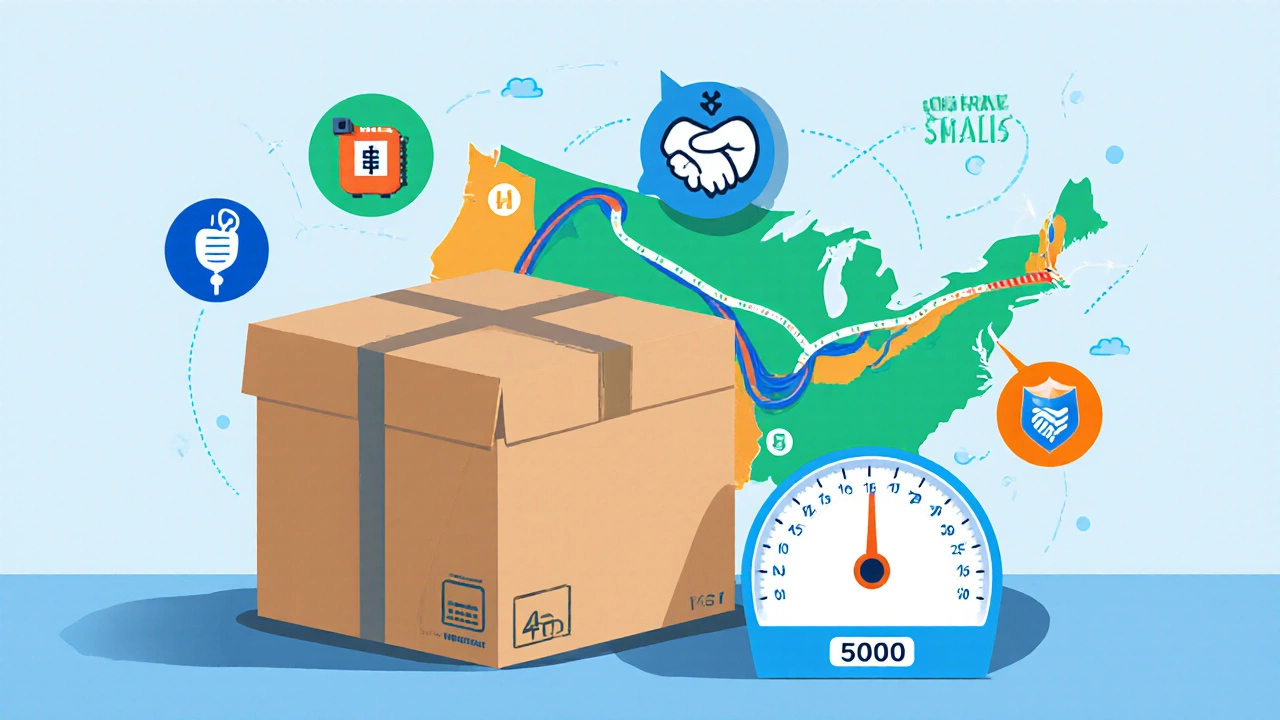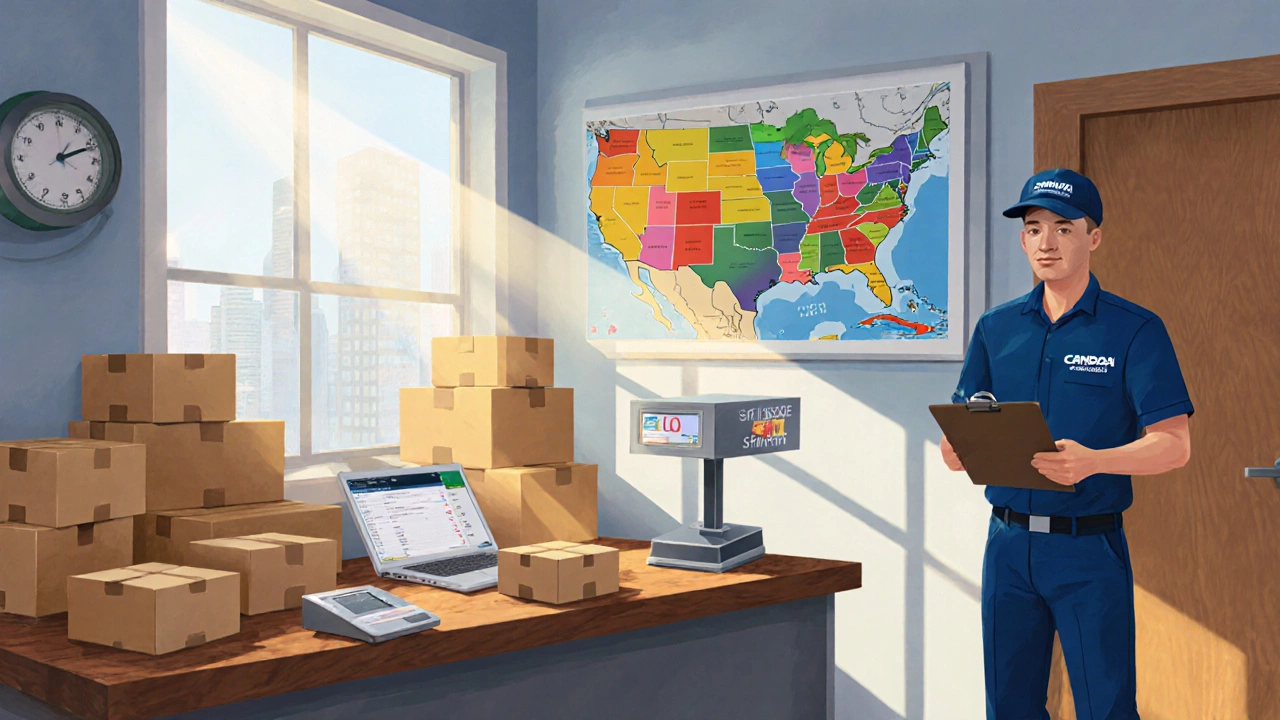Shipping Cost Calculator
Your package dimensions: 0.0 cm × 0.0 cm × 0.0 cm
Dimensional weight: 0.0 kg
Billable weight: 0.0 kg
Cost Components
| Base Rate | $0.00 |
| Fuel Surcharge | $0.00 |
| Pickup Fee | $0.00 |
| Total Before Insurance | $0.00 |
| Insurance Fee | $0.00 |
| Final Total | $0.00 |
Understanding how courier pricing works helps businesses avoid surprise costs and choose the right service level can save you time, money, and headaches. Whether you’re a small e‑commerce shop in Toronto or a midsize warehouse sending parcels across North America, the price tag you see on a carrier’s quote is never random. It’s a formula built from transparent components that you can break down, predict, and even negotiate.
Quick Takeaways
- Courier pricing is based on four core pillars: base rate, weight (or dimensional weight), geographic zone, and surcharges such as fuel or pickup fees.
- Most carriers publish zone maps; knowing your zone can cut costs by up to 15%.
- Dimensional weight often beats actual weight for lightweight, bulky packages.
- Negotiating contracts or using logistics software can reduce average shipping spend by 5‑10%.
- Regularly audit invoices to catch hidden fees like residential delivery or after‑hours pickup.
Pricing Components Explained
Below are the building blocks that appear on every courier invoice. By understanding each, you’ll see exactly why a $12.34 quote turned into $15.78 after a few extra minutes of reading.
Base Rate
Base rate is the starting amount a carrier charges for a shipment before any other factors are applied. It’s usually tied to the service level-ground, express, same‑day, etc.-and the weight bracket the package falls into.
Weight Tier
Weight tier categories shipments based on the physical weight measured in kilograms or pounds. Most carriers break weight into 0‑0.5 kg, 0.5‑1 kg, 1‑2 kg, and so on. The higher the tier, the steeper the per‑kilogram price.
Dimensional (Volumetric) Weight
When a package is large but light, carriers use dimensional weight calculated by multiplying length, width, and height and dividing by a carrier‑specific factor (often 5000 for metric). The billable weight is the greater of actual weight and dimensional weight.
Zone‑Based Pricing
Zone refers to a geographical grouping used by carriers to apply distance‑related rates. A shipment from Toronto to Vancouver might be Zone 5, while a local delivery stays in Zone 1. Most carriers provide a zone‑to‑zone matrix you can download.
Fuel Surcharge
Fuel surcharge is a variable percentage added to the base freight cost, linked to the national diesel price index. It fluctuates monthly; some carriers publish the exact multiplier on their website.
Additional Fees
Beyond the core pillars, carriers may tack on optional charges such as:
- Pickup fee - when the carrier comes to your door or warehouse.
- Delivery fee - for residential addresses, after‑hours, or weekend deliveries.
- Insurance - covers loss or damage beyond the carrier’s liability.
- Signature required - adds a verification step at the recipient’s end.
Step‑by‑Step Cost Calculation
Let’s walk through a real‑world example that many e‑commerce sellers in Canada encounter.
- Package dimensions: 40 cm × 30 cm × 20 cm (L × W × H).
- Actual weight: 2.2 kg.
- Calculate dimensional weight: (40 × 30 × 20) / 5000 = 4.8 kg (rounded up).
- Billable weight = max(2.2 kg, 4.8 kg) = 4.8 kg.
- Determine zone: Toronto (origin) to Calgary (destination) is Zone 4 according to Canada Post’s matrix.
- Base rate for Zone 4, 4‑kg tier, ground service = $9.00.
- Fuel surcharge (8% of base) = $0.72.
- Pickup fee (if carrier picks up from your warehouse) = $2.50.
- Total before optional services = $9.00 + $0.72 + $2.50 = $12.22.
- Add insurance (1 % of declared value, say $100) = $1.00.
- Final cost = $13.22.
By swapping to a carrier that uses a lower fuel surcharge multiplier or by consolidating the package to reduce dimensional weight, you could shave off a dollar or two per shipment.

Carrier Comparison Snapshot
| Carrier | Base Rate (Zone 4, 4 kg) | Fuel Surcharge | Pickup Fee | Typical Delivery Speed | Notes |
|---|---|---|---|---|---|
| Canada Post | $9.00 | 8 % | $2.50 | 2‑3 business days | Strong residential network |
| UPS | $10.20 | 6 % | $3.00 | 1‑2 business days | Higher reliability for express |
| FedEx | $10.80 | 7 % | $2.80 | 1‑2 business days | Better tracking granularity |
Use this table as a starting point when you request a contract quote. Most carriers will give you a volume‑based discount if you ship over a certain threshold per month.
Practical Tips to Reduce Shipping Costs
- Measure and pack wisely: Use the smallest box that safely fits the product. A 10‑cm reduction in each dimension can lower dimensional weight by up to 30%.
- Negotiate zone contracts: If you ship frequently to a specific region, ask the carrier for a “zone‑specific” discount.
- Leverage logistics software: Platforms that auto‑calculate dimensional weight and suggest the cheapest carrier per order can cut manual errors.
- Consolidate shipments: Group multiple orders into one pallet when possible; per‑parcel fees drop dramatically.
- Choose the right service level: Overnight shipping may be overkill for non‑time‑critical items. Ground or “economy” options are often just a few cents more per kilogram.
- Review invoices monthly: Spot unexpected surcharges early and dispute them before the carrier’s billing cycle closes.

Common Pitfalls to Avoid
Even seasoned shippers fall into traps that boost the final bill.
- Ignoring dimensional weight: Many novices only weigh parcels, forgetting that a bulky box can double the billable weight.
- Not checking zone maps: Assuming “province‑wide” rates can lead to hidden zone upgrades.
- Over‑insuring: Declaring a higher value than necessary inflates the insurance fee without added protection.
- Skipping carrier discounts: Most major carriers have volume‑based or e‑commerce‑specific programs; you need to apply.
- Late pickups: After‑hours pickups often incur an extra surcharge.
Mini FAQ - Your Shipping‑Cost Questions Answered
What is the difference between actual weight and dimensional weight?
Actual weight is the mass measured on a scale. Dimensional weight is calculated from the package’s volume (L × W × H ÷ a carrier‑specific factor). Carriers bill the higher of the two to ensure they’re compensated for space as well as mass.
How often do fuel surcharges change?
Most carriers update their fuel surcharge monthly, tying the percentage to the national diesel price index published by the government.
Can I get a lower rate by negotiating with carriers?
Yes. If you ship more than 500 parcels a month, carriers typically offer volume discounts, custom zone pricing, or waived pickup fees. Bring your shipment data to the table and ask for a contract rate.
Do I always need to pay for insurance?
Only if the declared value exceeds the carrier’s liability limit (often $100‑$200). For low‑value items, the built‑in coverage is sufficient and you can skip the extra fee.
What's the best way to check my shipment’s zone?
Download the carrier’s zone map from their website or use a shipping‑software plugin that auto‑assigns zones based on postal codes.
Armed with this knowledge, you can demystify any quote, negotiate better rates, and keep your shipping budget under control. The next time you see a price tag, you’ll know exactly which part of the formula is driving it, and you’ll have the tools to tweak it in your favor.





